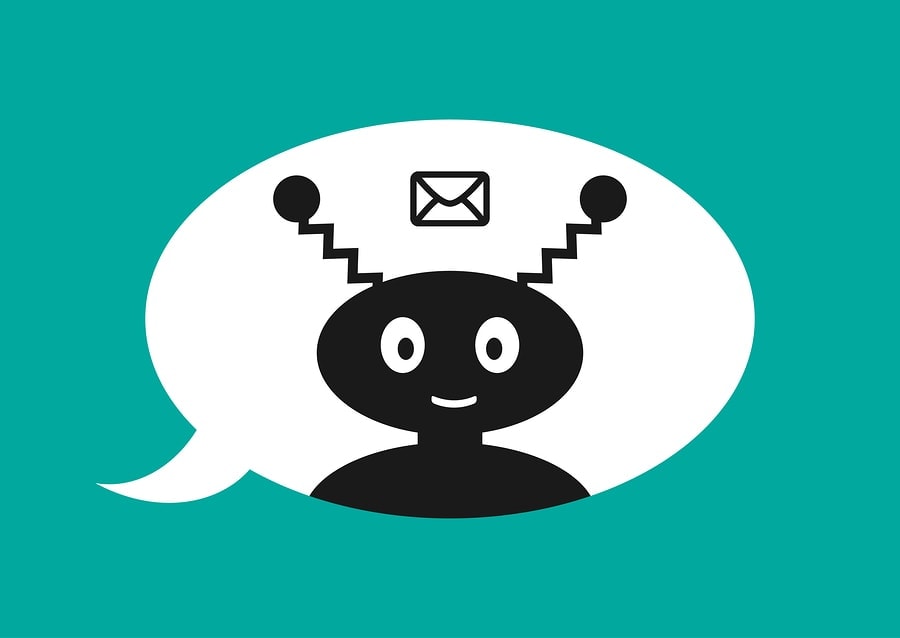Could the newest tool in digital marketing be what your business needs to improve customer experience and advance sales? With a chatbot as part of your marketing strategy, you’ll be able to tap into the latest technology for customer service, online shopping, audience engagement, and even get customer insights. Best of all, a chatbot can integrate right into your existing website or reach your customers on their preferred social media platform.
Marketing Chatbots 101
Even if you’ve never heard the word chatbot before today, chances are you’ve interacted with one. Those little widget boxes you sometimes see on websites offering help? That’s a chatbot. And of course, there’s Clippy the Paperclip from Microsoft Word. Also an early chatbot.
Chatbots are computer programs that mimic human conversation using artificial intelligence (AI) or machine learning. Interactions can range from simple (giving you a weather or traffic report) to complex (taking a customer order or suggesting products or services). Some chatbots have a pre-programmed series of responses, others are a little smarter, or have a human customer service rep standing by for trickier queries.
How to Use a Chatbot on Your Website
There are several ways you can use a chatbot on your website. Mostly, it just depends on your customer needs and marketing goals.
On-Demand Customer Service
Chatbots are the ultimate on-demand customer service rep. They’re ready to answer queries on your website 24/7, in every time zone, in any language you choose to program them in. This can help meet the needs of customers who increasingly want on-demand assistance, while also helping businesses cut costs.
Basic customer service chatbots can answer frequently asked questions (hours, location, shipping, and returns, etc.) or ask for preferences and make product recommendations. A more advanced bot could be programmed to take customized orders and complete a sale or start a prospect query that your live sales reps can follow up on the next morning.
Interactive User Engagement
Some brands like to use a chatbot for user engagement. The interactive, back-and-forth nature of a bot conversation can be more impactful for users than viewing a gallery, reading a blog, or watching a video.
Marketing experts say bot campaigns can boost brand loyalty and help provide social proof. Disney reportedly accomplished both with a chatbot messenger used to promote the movie “Zootopia.” Disney fans reportedly spent an average of 10 minutes interacting with the bot based on one of the movie’s characters.
Data Collection and Analysis
Chatbots are more than just the answers they serve up, with most programs keeping data on their interactions with customers and even providing analysis to help businesses analyze shopping patterns.
A bot can tell you what products or services are most popular or even which items a particular lead was most interested in. Bots can also help identify peak traffic times or note service issues that customers keep needing help resolving or site info they have trouble finding.
Creative Chatbot Marketing Campaigns
Chatbots aren’t as rare or gimmicky as some might think. In fact, 49% of marketers and digital business executives are currently using, testing, or planning to use chatbots, according to Forrester’s H2 2016 Global Mobile Executive Online Survey. As more brands adopt the technology, uses are getting more engaging and creative.
A sampling of uses:
- Estée Lauder created a personable chatbot that asks simple questions to find a customer’s best makeup match, shares a makeup tutorial, and then serves up a click-to-purchase button.
- National Geographic’s TV division created an Albert Einstein chatbot that shares selfies and personal details about the inventor’s life to promote the new TV series “Genius.”
- Whole Foods lets food shoppers search for recipes, Whole Foods products, or food “inspiration” via chatbot. The bot understands emoji, meaning you could send it a taco emoji and get results.
- Book publisher Harper Collins created a reader’s advisory chatbot to recommend similar titles and authors to booklovers. Readers are a fan of the brand’s quirky fun bot persona.
- Starbucks “barista bot” lets customers skip the line and place their coffee order from their phone. The bot allows for drink customization, online payment, and even barista tips.
Final Thoughts
Chatbots are a fun, new technology with a lot of potentials. While these examples may seem futuristic, most bots are following simple rules-based programming and standard AI protocols to respond to human customers. HAL 9000 they are not. Yet.
Forbes recommends a narrow application of the bot to provide the best value for interested customers, deploying the bot in owned channels where it can have a direct impact and integration with an overall marketing strategy.
Still, bots are likely to continue to get better and better as AI tech advances at lightning speed. Getting your business and your customers used to bots today could help your business shine in the future.
